Meet the 2022 NMR RABDF Gold Cup finalists
Five finalists are in the running for the 2022 Gold Cup award, sponsored by the Royal Association of British Dairy Farmers (RABDF) and National Milk Records (NMR).
Judges for the award are RABDF council members Di Wastenage and Peter Alvis and the 2019 Gold Cup winner Robert Sloan.
The winner will be announced at Dairy-Tech on the NMR stand at 4pm on Wednesday 1 February.
See also: Gold Cup winners 2003: Where are they now?
The five finalists are:
Liz Birkett
Rookhaye Farm, Salisbury, Wiltshire
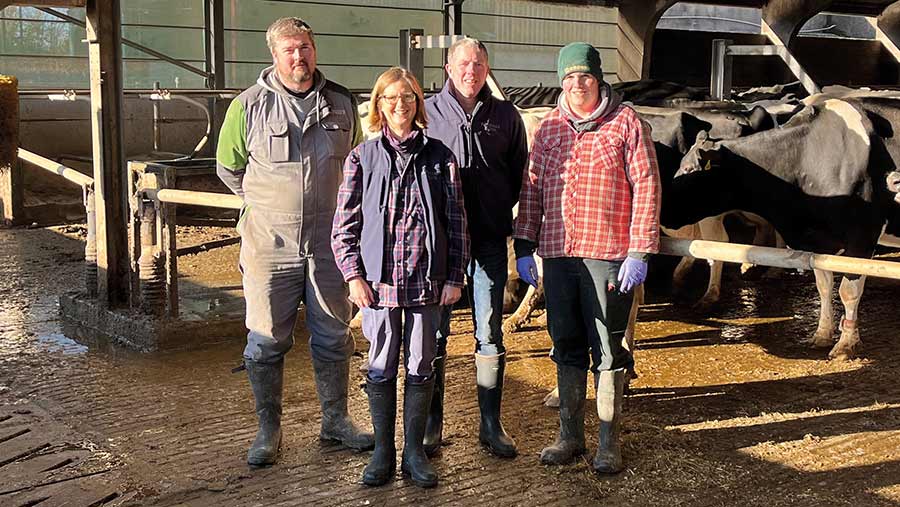
Martin Phillips, Liz Birkett, Paul Aylen, George Perrett © NMR © NMR
Farm facts
- 170 cows and followers
- 360ha (890 acre) mixed farm
- 11,270 litres of milk at 4.28% fat and 3.41% protein on twice-a-day milking
- Somatic cell count: 140,000 cells/ml
- All-year-round calving, housed herd
- Calving index: 372 days
- Mastitis rate: eight cases in 100 cows
- Replacement rate: 24%
- Pregnancy rate: 28%
- Selling milk to Muller Sainsbury’s
Liz Birkett is vying for the trophy for after being beaten at the final hurdle in 2019.
All-round performance has improved significantly, and she is producing 4,000 litres from forage. This is being achieved by adopting a multi-cut silage system.
Two-year leys of grass and red clover and maize are integrated into the arable crop rotation.
While milk yields and quality have always been important drivers to this dairy business, longevity and low-maintenance cows underpin the breeding goals.
All heifers are genomically tested, with the best bred to sexed semen.
The herd has been closed since 2016 and strict biosecurity is adhered to.
Calves are vaccinated for infectious bovine rhinotracheitis (IBR) and bovine viral diarrhoea (BVD), and all cows are routinely screened for Johne’s using NMR’s HerdWise service.
Less than 4% of cows have infection levels J4 and J5 (sub-clinical and clinical), and these are not used for breeding.
Strict hygiene and parlour routines and a move to sand bedding in cubicles have contributed to reduced mastitis rates of eight cases in every 100 cows.
This has meant that antibiotics at drying off have been cut, with only 15% of cows getting treated.
Chris Ford, C&H Ford Farm
Peadon Farm, Bridgwater, Somerset
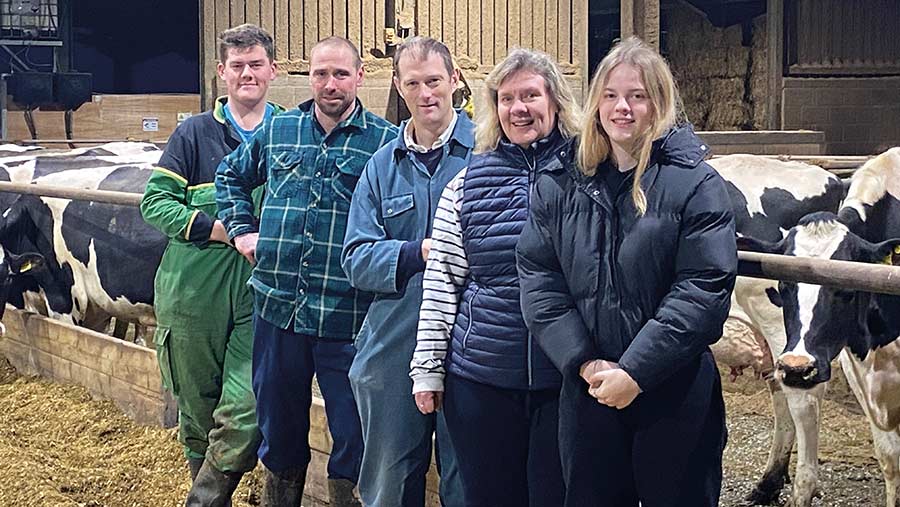
© NMR
Farm Facts
- 600 pedigree Holstein cows and followers
- 275ha (680 acres)
- Producing 12,214 litres at 3.84% butterfat and 3.28% protein on three-times-a-day milking
- All-year-round calving herd, housed indoors
- Average age at first calving 20.9 months
- Pregnancy rate: 34%
- Mastitis rate: 10 cases for every 100 cows
- Somatic cell count: 127,000 cells/ml
- Pregnancy rate: 34%
- Supplies Muller – TSDG contract
First-generation tenant farmers Chris and Helen Ford have established a high-production, high-health herd in just seven years.
The herd has been closed since 2018 and last year they sold 237 surplus cows to other farmers.
Dry cow antibiotics have been reduced from 100% to 9%, and a new transition shed with sand cubicles is also helping to improve udder health.
They test for BVD and IBR and screen for Johne’s using HerdWise, with support on control measures from their vet. The herd has only 1% J4 or J5 cows (sub-clinical and clinical).
Cows are selected carefully for breeding and sexed semen is used on the maiden heifers and the best cows, ranked on a combination of production, health and fertility.
Milk from forage is running at 41% and the feed rate is 0.27kg/litre.
Alistair Logan
Holehouse Farms, Kilbirnie, Ayrshire
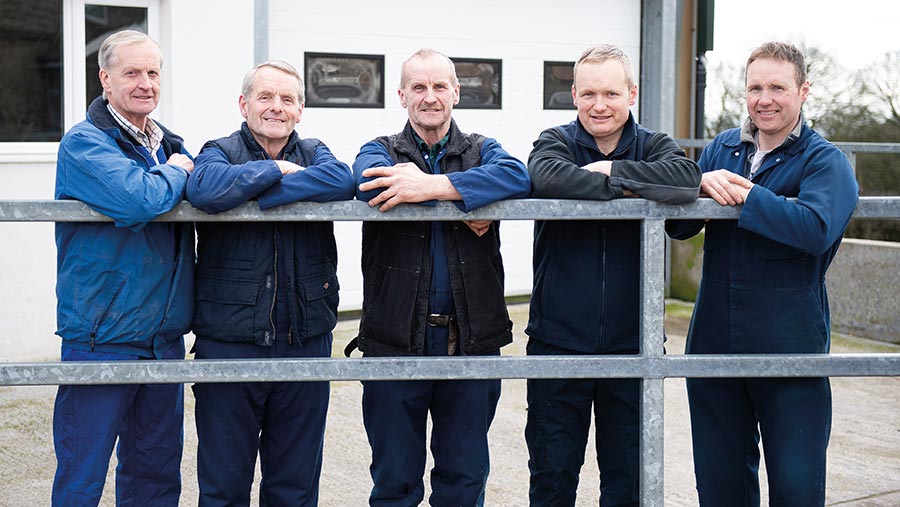
Alex, Tom and Hugh Logan, farm along with Tom’s sons, Alistair and Stuart © NMR
Farm Facts
- 280 pedigree Holstein cows, with the majority Red and White, 160 suckler cows and followers and 1,700 ewes
- Average yield: 10,500 litres at 4.10% butterfat and 3.40% protein
- All-year-round calving herd, housed indoors
- Somatic cell count: 115,000 cells/ml
- Replacement rate: 32%
- Calving interval: 382 days
- Pregnancy rate: 23%
- Herd health: Mastitis rate 28%
- 1,930ha (4,767 acres)
- Supplies Muller
Technology and renewable energy are helping the fifth-generation Logan family maximise cow health and welfare at Holehouse Farms.
Investing in a new dairy unit and improving calf housing have helped lower antibiotics use across the herd to 16.09mg/population correction unit (PCU).
Heifers are calving down at 26 months with a low mortality rate of 3% from birth to calving.
The farm is a net exporter of electricity through a 950kw hydroelectric plant, solar panels and a biomass boiler.
Next year they are installing a 3MW wind turbine. Furthermore, the cows are bedded on recycled manure green bedding.
All cows are fitted with Cow Manager ear tag sensors that record rumination, eating, activity and cow temperature. This has helped lift the pregnancy rate to 23%.
Meanwhile, Delaval body condition-scoring cameras help highlight any health or nutritional issues.
They also have an automatic footbath and use a Lely Discovery scraper.
In the past five years, they have reseeded all silage ground with hybrid Italian ryegrass and done extensive soil sampling to target nutrients and maximise yields.
Breeding focuses on a medium-sized, robust, high-yielding Holstein with positive health traits, fertility and lifespan. Sexed semen is used on 75% of the herd, with the rest put in calf to beef.
Stuart and George Orr
Kaemuir Farm, Avonbridge
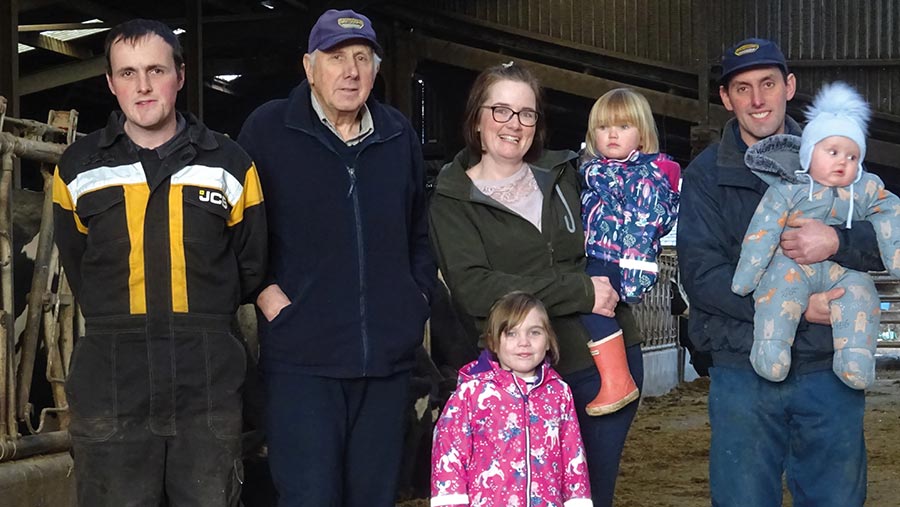
Scott, George, Sophie, Alison, Rachel, Stuart and baby James Orr © NMR
Farm Facts
- Milking 260 cows
- Average yield: 10,258 litres at 3.98% butterfat and 3.25% protein
- Feed rate: 0.37kg/litre
- All-year-round calving, housed herd
- Somatic cell count 100,000 cells/ml
- Replacement rate: 27%
- Calving interval: 368 days
- Herd health: Mastitis rate 8%
- 200ha (494 acres)
A strict breeding and health policy is central to the top performance achieved at Kaemuir Farm.
The Orrs aim to breed a long-lived and well-balanced cow using the Genus genetic programme. All heifers and top-performing cows are put in calf to sexed semen to minimise unwanted black and white bulls.
Since 2011, calving interval has gone from 417 days to 368 days and age at first calving has been reduced to 22 months, with 91% calving down and 95% making it to the second lactation.
Health is a high priority. Use of non-critical antibiotics is now 12mg/PCU and zero for critical antibiotics. Low heifer calf mortality of just 2% from birth to calving reflects their strict hygiene and health protocols.
The herd is tested for Johne’s, leptospirosis and IBR and is vaccinated for the latter two annually, with milk screened quarterly for key diseases. The herd is also BVD-free.
The Orrs have 160ha (395 acres) of land dedicated to growing food for the cows and reseed around 20ha (50 acres) of grassland yearly.
This is is usually cropped with winter wheat, to help weed control, before going back into grass.
Soil testing helps them target the correct nutrients to the ground. They have also received a grant to invest in a dribble bar to improve the use of slurry and reduce emissions.
Andrew, Oliver and Wendy Reed
France Farm, Cullompton, Devon
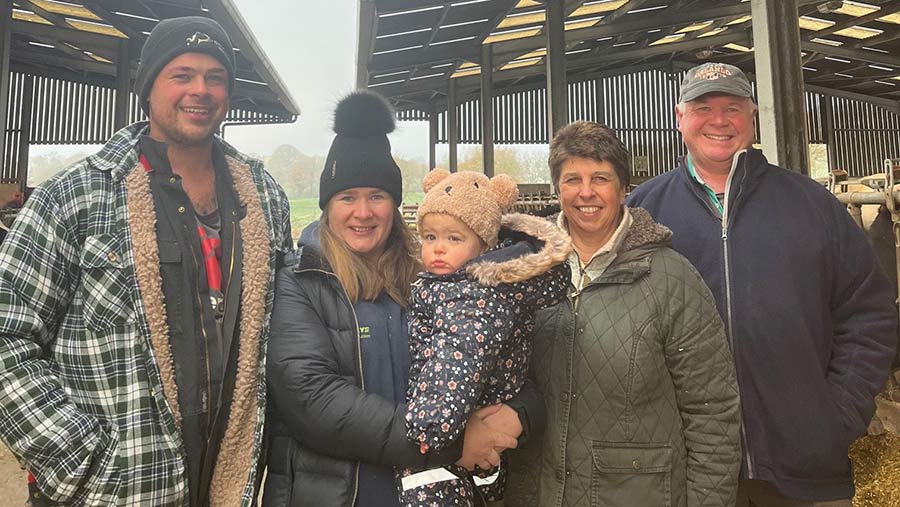
Olly, Becca, Eloise, Wendy and Andrew Reed © NMR
Farm Facts
- 180 pedigree Holsteins
- Average yield: 13,000 litres at 4.00% butterfat and 3.29% protein
- All-year-round calving herd, housed indoors
- Somatic cell count: 102,000 cells/ml
- Replacement rate: 16%
- Calving interval: 387 days
- Pregnancy rate: 21%
- Herd health: Mastitis rate 4.5%
- 142ha (351 acres)
- Supplies Crediton Dairy
Breeding for longevity and functionality is helping the Reed family keep replacement rates low, at 16%.
The family have built a strong reputation for producing quality breeding stock, with about 50 animals sold a year.
Cows are milked by three A4 Lely robots and herd health is exceptional with mastitis down at just 4.5 cases for every 100 cows, and antibiotics use reduced from 19mg/PCU in 2018 to just below 10mg/PCU.
By making better use of manure and routinely soil sampling, the Reeds have managed to more than halve their fertiliser usage from 45t to 20t/year.
They have just joined a Mid-Tier Countryside Stewardship Scheme and established 30ha (74 acres) of leguminous swards and wildflower mixes.
The aim is to increase the silage protein content and further reduce fertiliser usage.
